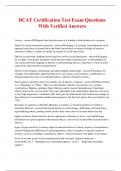BCAT Certification T est Exam Questions With Verified Answers Latency - answer✔✔Elapsed time f rom the onset of a stimulus to the initiation of a response Deficits in social -emotional reciprocity - answer✔✔ranging, for example, from abnormal social approach and failure of normal back -and-forth conversation; to reduced sharing of interests, emotions or affect, to failure to initiate or respond to social interactions. Deficits in nonverbal communicative behaviors used for social interaction - answer✔✔ranging for example, from poorly integrated verbal and nonverbal communication; to abnormalities in eye contact and body language or deficits in understanding and use of gestures; to lack of facial expressions and nonverbal communication. Deficits in developing, maintaining, and understanding relationships - answer✔✔ranging, for example, from difficulties a djusting behavior to suit various social contexts, to difficulties in sharing imaginative play or in making friends, to absence of interest in peers. Stereotyped or repetitive motor movements, use of objects, or Speech - answer✔✔Often referred to as "Stimm ing" or "Stims". These are self -initiated, repetitive movements (e.g. rocking, vocalizations, flapping, spinning, finger -flicking, and/or unusual manipulation of inanimate objects) that can be vocal or motor. For some individuals with Autism these behavior s can occur at very high frequencies, sometimes 100+ times per day. Individuals with Autism may engage in these behaviors for automatic reinforcement purposes, but that isn't always the case (function can vary). Insistence on sameness, inflexible adherence to routines, or ritualized patterns of verbal or nonverbal behavior - answer✔✔extreme distress at small changes, difficulties with transitions, rigid thinking pattern, greeting rituals, need to take same route or eat same food every day highly restricted, fixated interests that are abnormal in intensity or focus - answer✔✔strong attachment to or preoccupation with unusual objects, excessively circumscribed or perseverative interests hyper or hypo reactivity to sensory input or unusual interests in sensory aspects of environment - answer✔✔apparent indifference to pain/temperature, adverse response to specific sounds or textures, excessive smelling or touching of objects, visual fascination with lights or movement levels of severity across social communicatio n and restricted, repetitive behaviors - answer✔✔Level 3 - "Requiring very substantial support," Level 2 - "Requiring substantial support," Level 1 - "Requiring support." research regarding treatment intensity - answer✔✔Results indicate a strong relations hip between treatment intensity and mastery of learning objectives, where higher treatment intensity predicted greater progress. early intensive behavioral intervention research - answer✔✔EIBI is a type of Applied Behavioral Analysis focused on children un der five years of age. New research has shown that while intensive behavioral interventions work well with all children, children starting before the age of two were likely to make the most significant gains. For EIBI to be successful children are provided with 20 to 40 hours of one -on-one therapy and families are also incorporated into the process so that young children get as much exposure as possible. foundational autism research - answer✔✔Dr. Margaret Bauman was the first researcher to discover the anat omical differences between a typical brain and a brain with autism alongside her colleague, Dr. Thomas Kemper. Their discovery demonstrated for the first time that autism was related to abnormalities of brain development and not to poor parenting. Until th eir discovery, autism had actually been blamed on the "refrigerator mother" - a term that suspected the child's disability was a result of his/her parent's emotional coldness. Distinguishing between evidence -based interventions - - answer✔✔Evidence -based p ractice involves the integration of research findings with: Professional judgment and data -based clinical decision -making, Values and preferences of families, Assessment and Improvement of the capacity of the delivery system to implement the intervention w ith a high degree of procedural accuracy Positive reinforcement - answer✔✔an event in which a stimulus occurs contingent on a response, resulting in the increase in future probability of that response Negative reinforcement - answer✔✔Behavior increases or maintains the same as a function of the contingent removal of the stimulus Positive punishment - answer✔✔An event in which a stimulus (typically unpleasant) occurs contingent on a response, resulting in a decrease in the future probability of that response Negative punishment - answer✔✔The removal or reduction of positive reinforcers as a consequence of a response, resulting in the reduction in the of that response Reinforcer - answer✔✔something used to motivate a learner to complete a task, or engage in a behavior. Conditioned reinforcer - answer✔✔a stimulus that initially lacked reinforcing properties, but has acquired those by being paired with primary or strong secondary reinforcers Unconditioned reinforcer - answer✔✔stimulus that is reinforcing in the absence of any prior learning




